2019 MERCEDES-BENZ SLC ROADSTER belt
[x] Cancel search: beltPage 42 of 306
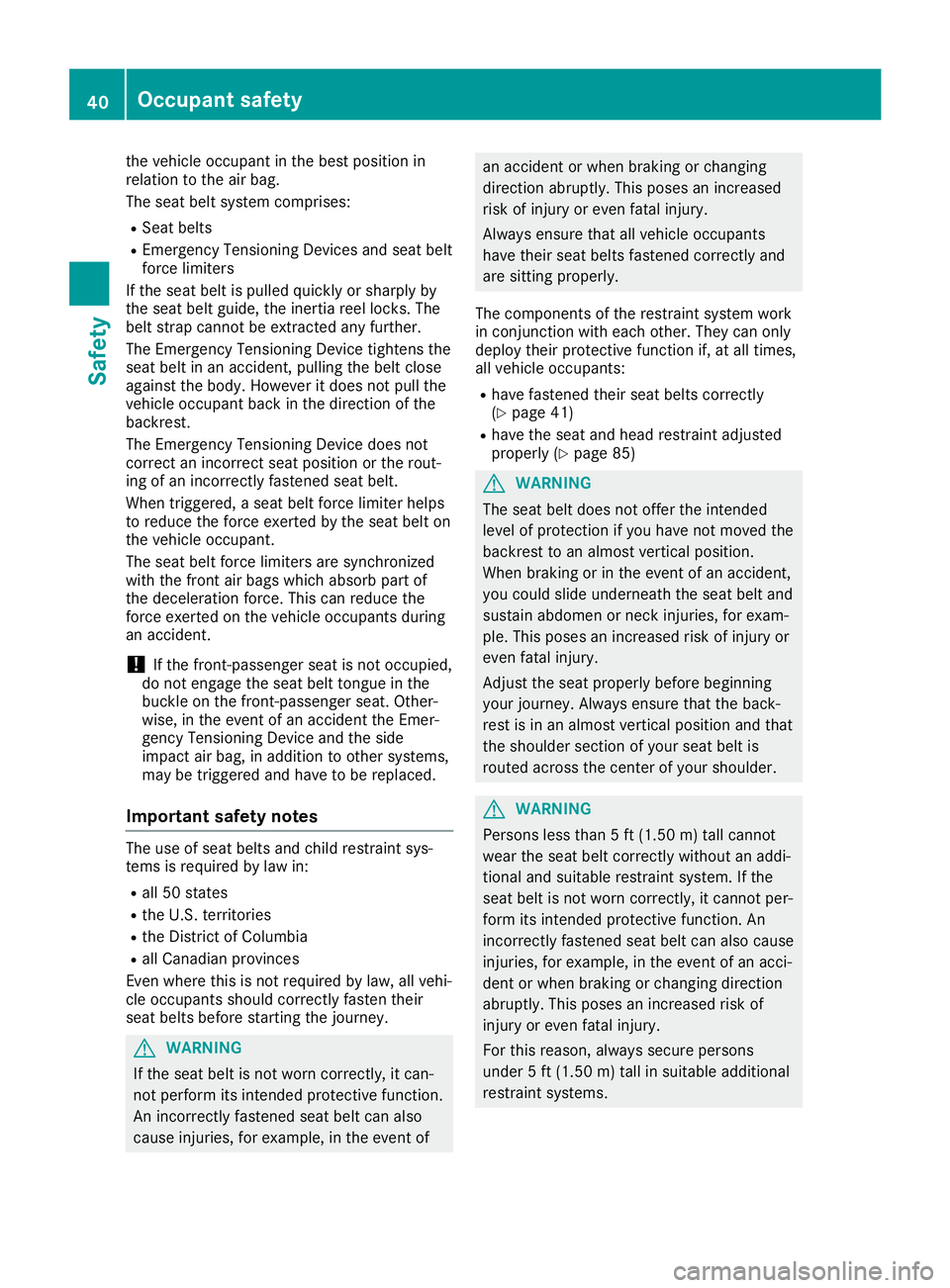
the
vehicleoccu pant inthe best po sitio nin
rel ation tothe airba g.
The seat beltsy ste mcomp rises:
R Sea tbe lts
R Emer gency Tensi oni ng Devi cesand seat belt
for ce limi ters
If the seat beltis pu lled quickl yor sha rplyby
the seat beltgu ide, the inertia reello cks. The
be ltstra pcann otbe extra ctedanyfurthe r.
The Emer gency Tensi oni ng Devi cetighte nsthe
se at beltin an acc ident, pulling the beltclo se
ag ainst the body.How everit do es not pullthe
veh icleoccu pant back inthe directi onofthe
ba ckre st.
The Emer gency Tensi oni ng Devi cedoes not
corr ectaninco rrectseat positio nor the rout-
ing ofan inco rrectly faste ned seat belt.
Wh entrig gered ,a se at beltfor ce limi ter helps
to red uce theforce exe rted bythe seat belton
the vehicleoccu pant.
The seat beltfor ce limi ters aresy nchro nized
wi th the frontairba gs which absor bpa rtof
the decel era tionfor ce. Thiscan reduce the
for ce exe rted onthe vehicleoccu pants durin g
an acc ident.
! If
the front-pa ssenge rse at isnot occu pied ,
do not engagethe seat belttong ueinthe
bu ckle onthe front-pa ssenge rse at. Othe r-
wi se ,in the eventofan acc ident theEmer -
ge ncy Tensi oni ng Devi ceand theside
im pact airba g,in ad ditio nto othe rsy ste ms,
ma ybe trig gered and have tobe rep laced .
Impo rtant safety notes The
useof seat belts and childres traint sys-
tems isreq uired bylaw in:
R all50 states
R the U.S. territories
R the Distric tof Co lumbi a
R allCa nad ian pro vinces
Even where thisis not required bylaw, allveh i-
cle occu pants should corr ectlyfa ste nthe ir
se at belts befor esta rtin gthe journey . G
WA
RNING
If the seat beltis not worncorr ectly,itcan-
not perfo rm itsinte ndedpro tecti vefunctio n.
An inco rrectly faste ned seat beltcan also
cau seinju ries,for exa mpl e,inthe eventof an
acc ident orwh en bra king orcha nging
di rec tionab ruptl y.Th ispo sesan incr eased
ris kof inju ryor eve nfa tal inju ry.
Alw aysens uretha tal lveh icleoccu pants
ha ve the irse at belts faste ned correctlyand
ar esitting properly.
The comp onents ofthe restraint syste mwo rk
in conju nctionwi th each othe r.Th ey can only
de ploy the irpro tecti vefunctio nif, at alltim es,
al lveh icleoccu pants:
R ha ve faste ned theirse at belts corr ectly
(Y page 41)
R ha ve the seat and head res traint adjus ted
pro perly (Ypage 85) G
WA
RNING
The seat beltdo es not offerthe intended
le vel ofpro tecti onifyo uha ve not mov edthe
ba ckre stto an almos tver tica lpo sitio n.
Wh enbra king orinthe eventofan acc ident,
yo ucou ldslid e und erne aththe seat beltand
su sta inab do men orneck injuries,for exa m-
pl e. Thispo sesan incr easedris kof inju ryor
eve nfa tal inju ry.
Adju stthe seat pro perly befor ebe ginning
yo ur jou rney .Alw aysens uretha tthe back-
res tis in an almos tver tica lpo sitio nand that
the shoulde rse ctio nof your seat beltis
rou ted across thecente rof your sho ulde r. G
WA
RNING
Pe rso nsless tha n5 ft (1.5 0m) tallcann ot
we arthe seat beltcorr ectlywi thou tan addi-
tio nal and suita ble res traint syste m. Ifthe
se at beltis not worncorr ectly,itcann otper-
for mits inte ndedpro tecti vefunctio n.An
inco rrectly faste ned seat beltcan also cau se
inju ries,for exa mpl e,inthe eventofan acc i-
de nt or wh en bra king orcha nging directi on
ab ruptl y.Thi spo sesan incr easedris kof
inju ryor eve nfa tal inju ry.
For thisrea son ,al wa yssecur epe rso ns
und er5ft (1.5 0m) tallin suita ble ad ditio nal
res traint syste ms. 40
Oc
cupant safetySafe ty
Page 43 of 306
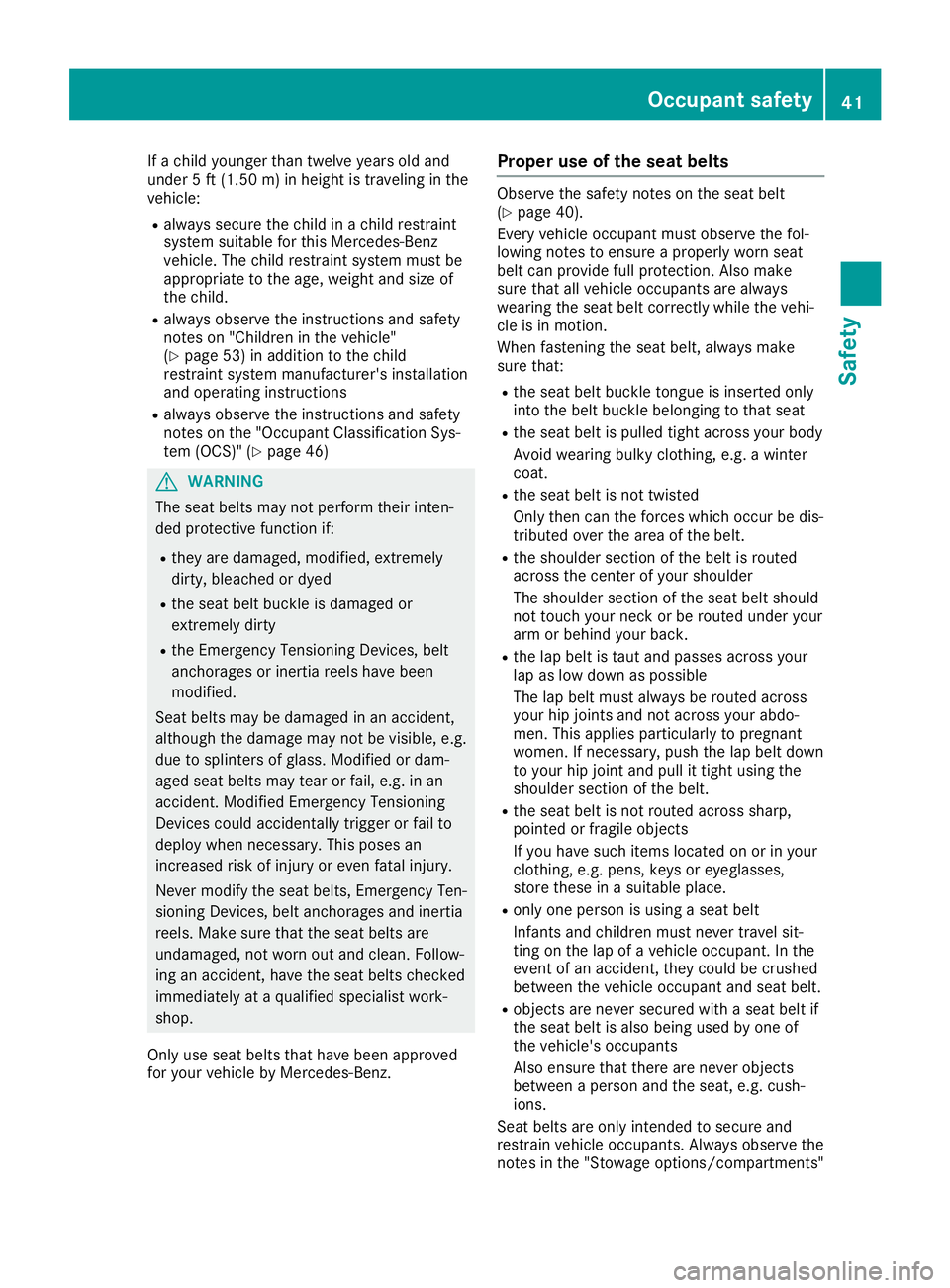
If
achild younger thantwelve yearsold and
under 5ft (1.5 0m) inheight istravelin gin the
vehic le:
R always securethe child inachild restraint
syst emsuitable forthis Merc edes- Benz
vehic le.The child restraint systemmust be
appropr iatetothe age, weight andsize of
the child.
R always observethe instruct ions andsafet y
not eson "Children inthe vehic le"
(Y page 53)inaddition tothe child
rest raint systemmanuf acturer' sinst allation
and operat inginst ruct ions
R always observethe instruct ions andsafet y
not eson the "Occ upant Classific ationSys-
tem (OCS)" (Ypage 46) G
WARN
ING
The seat belts maynotperf orm theirint en-
ded protective func tion if:
R the yare damaged, modified,extreme ly
dirt y,bleache dor dyed
R the seat beltbuck leisdamaged or
ext reme lydirt y
R the Emergen cyTens ionin gDev ices, belt
anc horage sor iner tiareels havebeen
modif ied.
Seat belts maybedamaged inan acc ident ,
althoug hthe damage maynotbevisible, e.g.
due tosplint ersofglass. Modifie dor dam-
aged seatbelts maytearorfail, e.g. inan
acc ident .Modifie dEm ergen cyTens ionin g
Dev ices could accident allytrigger orfail to
deploy whennecessary. Thisposes an
inc reased riskofinjury oreven fatalinj ury.
Never modifythe seat belts ,Em ergen cyTen-
sion ingDev ices, beltanchorage sand inertia
reels. Make surethattheseat belts are
undamage d,not worn outand clean .Follow-
ing anacc ident ,have theseat belts checked
immed iatelyataqualified specialist work-
shop.
Only useseat belts thathave been approv ed
for your vehic leby Merc edes- Benz. Prop
eruse oftheseat belts Obser
vethe safet ynot eson the seat belt
(Y page 40).
Ev ery vehic leocc upant mustobservethe fol-
lowing notestoens ure aproper lyworn seat
belt canprov idefull prot ection. Also make
sure thatallvehic leocc upant sare always
wearin gthe seat beltcorrectlywhile thevehi-
cle isin mot ion.
When fastenin gthe seat belt, always make
sure that:
R the seat beltbuck leton gue isinse rted only
int othe belt buck lebelon gingtothat seat
R the seat beltispulled tightacro ssyour body
Av oid wearin gbulky clothing ,e.g. awint er
coat .
R the seat beltisnot twist ed
Only thencan theforces which occurbe dis-
tr ibuted overthearea ofthe belt.
R the shoulder sectionofthe belt isrout ed
acro ssthe centerofyour shoulder
The shoulder sectionofthe seat beltshould
not touc hyour neckor be rout edunder your
arm orbehin dyour back.
R the lapbelt istaut andpasses acrossyour
lap aslow down aspossible
The lapbelt must always berout edacro ss
your hipjointsand notacro ssyour abdo-
men .This applies particularly topregn ant
women .If nec essary, pushthelapbelt down
to your hipjointand pullittigh tusing the
shoulder sectionofthe belt.
R the seat beltisnot rout edacro sssharp,
point edorfragile objects
If you have such itemslocat edon orinyour
clot hing ,e.g. pens ,keys oreyeglasses ,
sto rethe seinasuitable place.
R only oneperso nis using aseat belt
Inf ant sand childr enmust nevertravel sit-
tin gon the lapofavehic leocc upant .In the
even tof an acc ident ,the ycould becrus hed
betwee nthe vehic leocc upant andseat belt.
R obje ctsare neversecur edwith aseat beltif
the seat beltisalso being usedbyone of
the vehic le'soccupant s
Also ensure that thereare neverobje cts
betwee naperso nand theseat, e.g.cush-
ions .
Seat belts areonly intended tosecur eand
rest rain vehic leocc upant s.Always observethe
not esinthe "Stowage options/com partmen ts" Occupa
ntsaf ety
41Safety Z
Page 44 of 306
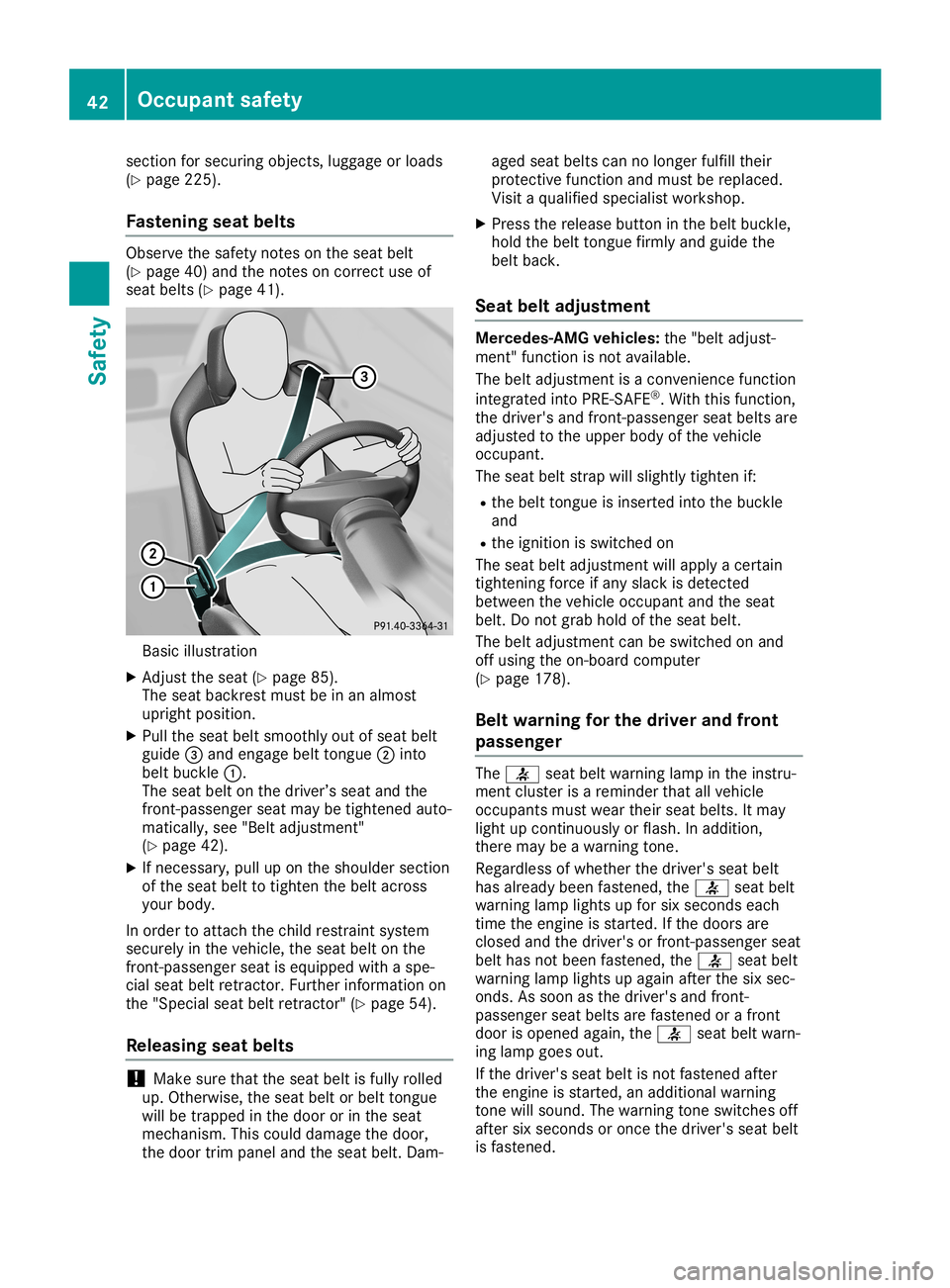
section
forsecuring objects,luggageorloads
(Y page 225).
Fastening seatbelts Observe
thesafety notesonthe seat belt
(Y page 40)and thenotes oncorrect useof
seat belts (Ypage 41). Basic
illustration
X Adjust theseat (Ypage 85).
The seat backrest mustbeinan almost
upright position.
X Pull theseat beltsmoothly outofseat belt
guide 0087and engage belttongue 0044into
belt buckle 0043.
The seat beltonthe driver’s seatandthe
front -passenger seatmaybetightened auto-
matically ,see "Belt adjustment"
(Y page 42).
X Ifnecessary, pullupon the shoulde rsection
of the seat belttotighten thebelt across
your body.
In order toattach thechild restraint system
securely inthe vehicle, theseat beltonthe
front -passenger seatisequip pedwith aspe-
cial seat beltretractor .Further information on
the "Special seatbeltretractor "(Y page 54).
Releasing seatbelts !
Make
surethattheseat beltisfully rolled
up. Otherwise, theseat beltorbelt tongue
will betrapped inthe door orinthe seat
mechanism. Thiscould damage thedoor,
the door trimpanel andtheseat belt. Dam- aged
seatbelts cannolonger fulfilltheir
protective functionandmust bereplaced.
Visit aqual ified speciali stworkshop.
X Press therelease buttoninthe belt buckle,
hold thebelt tongue firmlyandguide the
belt back.
Seat beltadjustment Mercedes-AMG
vehicles:the "belt adjust-
ment" function isnot avail able.
The belt adjustment isaconven iencefunction
integrated intoPRE-SA FE®
.With thisfunction,
the driver's andfront -passenger seatbelts are
adjusted tothe upper bodyofthe vehicle
occupant.
The seat beltstrap willslightly tightenif:
R the belt tongue isinserted intothebuckle
and
R the ignition isswitched on
The seat beltadjustment willapply acertain
tightening forceifany slack isdetected
between thevehicle occupant andtheseat
belt. Donot grab holdofthe seat belt.
The belt adjustment canbeswitched onand
off using theon-board computer
(Y page 178).
Belt warning forthe driver andfront
passenger The
0076 seatbeltwarning lampinthe instru-
ment cluster isareminder thatallvehicle
occupants mustweartheirseatbelts. Itmay
light upcont inuously orflash. Inaddition,
there maybeawarning tone.
Regard lessofwhether thedriver's seatbelt
has alread ybeen fastened, the0076 seatbelt
warning lamplights upfor sixseconds each
time theengine isstarted. Ifthe doors are
closed andthedriver's orfront -passenger seat
belt hasnotbeen fastened, the0076 seatbelt
warning lamplights upagai nafter thesixsec-
onds. Assoon asthe driver's andfront -
passenger seatbelts arefastened orafront
door isopened again,the 0076 seatbeltwarn-
ing lamp goesout.
If the driver's seatbeltisnot fastened after
the engine isstarted, anadditional warning
tone willsound. Thewarning toneswitches off
after sixseconds oronce thedriver's seatbelt
is fastened. 42
Occ
upant safetySafety
Page 45 of 306
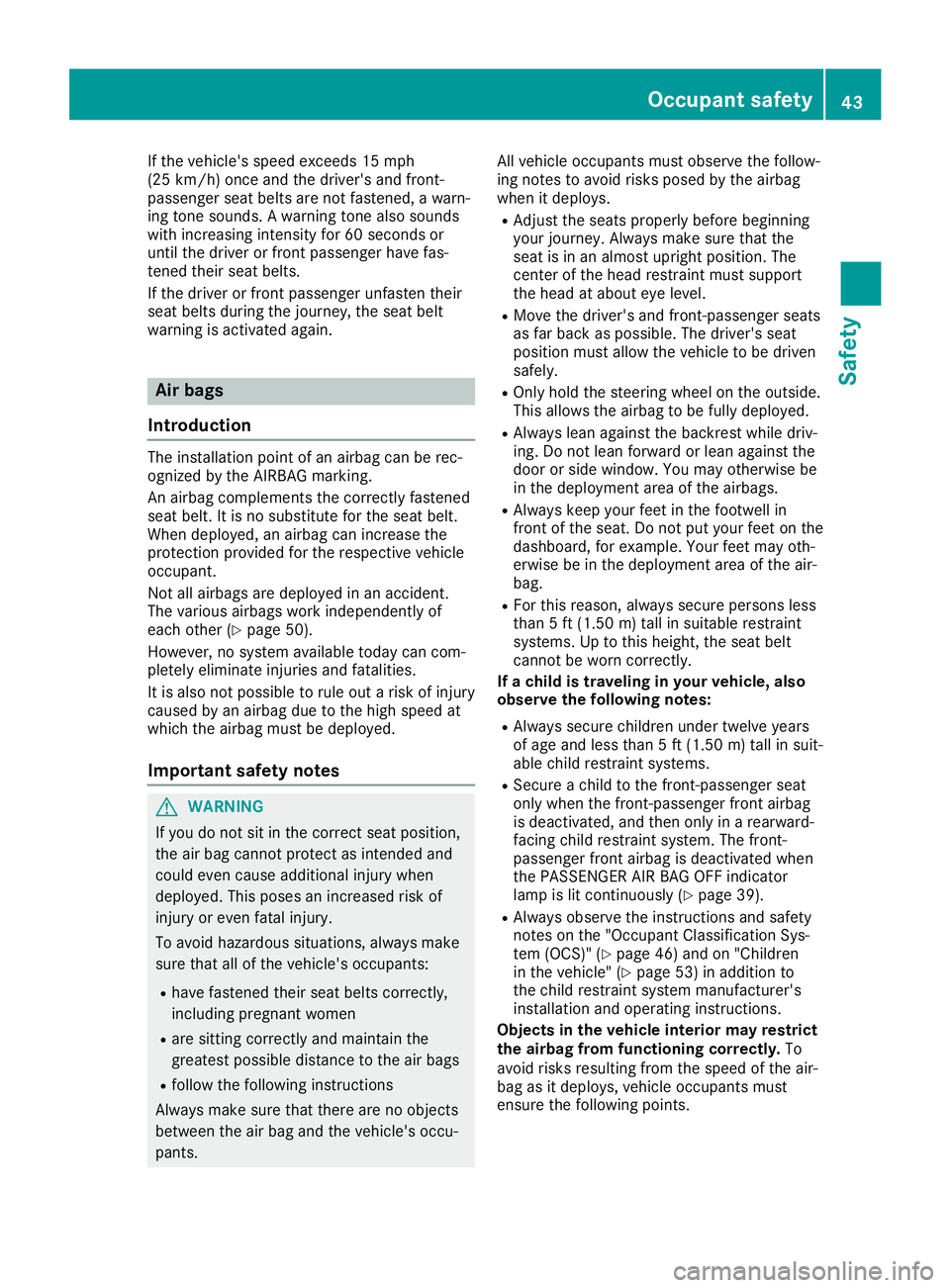
If
the vehicle 'sspeed exceeds 15mph
(25 km/h) onceandthedriver's andfront-
passe ngerseatbelts arenot fastened, awarn-
ing tone sounds. Awarning tonealsosounds
with increasing intensityfor60seconds or
until thedriver orfront passe ngerhave fas-
tened theirseatbelts.
If the driver orfront passe ngerunfasten their
seat belts duringthe journey, theseat belt
warning isactivated again. Air
bags
Introductio n The
installa tionpoint ofan airb agcan berec-
ognized bythe AIRBAG marking.
An airb agcomplements thecorrectly fastened
seat belt. Itis no substitu tefor the seat belt.
When deployed ,an airb agcan increase the
protection providedfor the respective vehicle
occupant.
Not allairb ags aredepl oyed inan accident.
The variou sairb ags work indepe ndently of
each other (Ypage 50).
However, nosystem availabletoday cancom-
pletel yelimi nate injuries andfatali ties.
It is also notpossib leto rule outarisk ofinjury
cause dby an airb agdue tothe high speed at
which theairbagmust bedepl oyed .
Important safetynotes G
WARNING
If you donot sitinthe correct seatpositio n,
the airbag cannot protect asintended and
could evencause additional injurywhen
depl oyed .This poses anincreased riskof
injury oreven fatalinjury.
To avoid hazardo ussitua tions, always make
sure thatallofthe vehicle 'soccupants:
R have fastened theirseatbelts correctly,
includi ngpregnant women
R are sitting correctly andmaintain the
greatest possibledistance tothe airbags
R follow thefollow inginstructions
Alway smake surethatthere arenoobjects
betwee nthe airbag and thevehicle 'soccu-
pants. All
vehicle occupants mustobserve thefollow -
ing notes toavoid risksposed bythe airbag
when itdepl oys.
R Adjust theseats properl ybefore beginning
you rjourney. Alwaysmake surethatthe
seat isin an almos tupri ghtpositio n.The
center ofthe head restraint mustsupport
the head atabou teye level .
R Move thedriver's andfront-passenger seats
as far back aspossib le.The driver's seat
positio nmust allow the vehicle tobe driven
safel y.
R Only holdthesteering wheelonthe outsid e.
This allows theairbagtobe fullydepl oyed .
R Alway slea naga inst thebackrest whiledriv-
ing. Donot leanforward orlea naga inst the
door orside window .You may otherwise be
in the depl oyment areaofthe airbags.
R Alway skeep yourfeet inthe footwell in
front ofthe seat. Donot putyourfeet onthe
dashb oard,forexample .Your feetmay oth-
erwis ebe inthe depl oyment areaofthe air-
bag.
R For this reason, always secure persons less
than 5ft (1.50 m)tall insuita blerestraint
systems. Uptothis heigh t,the seat belt
cannot beworn correctly.
If achil dis traveling inyour vehic le,also
obse rvethe followi ngnotes:
R Alway ssecure childrenunder twelve years
of age and less than 5ft (1.50 m)tall insuit-
abl echild restraint systems.
R Secure achild tothe front-passenger seat
only when thefront-passenger frontairbag
is deactiva ted,andthen onlyinarearwa rd-
facing childrestraint system.Thefront-
passe ngerfront airbagisdeactiva tedwhen
the PASSENGER AIRBAG OFFindicator
lamp islit continuously (Ypage 39).
R Alway sobserve theinstructions andsafety
notes onthe "Occupa ntCla ssifica tionSys-
tem (OCS)" (Ypage 46)and on"Ch ildre n
in the vehicle "(Y page 53)inaddi tion to
the child restraint systemmanufacture r's
installa tionandopera tinginstructions.
Objects inthe vehic leinterio rmay restrict
the airbag fromfunctio ningcorrec tly.To
avoid risksresultingfrom thespeed ofthe air-
bag asitdepl oys, vehicle occupants must
ensure thefollow ingpoints. Occ
upant safety
43Safety Z
Page 47 of 306
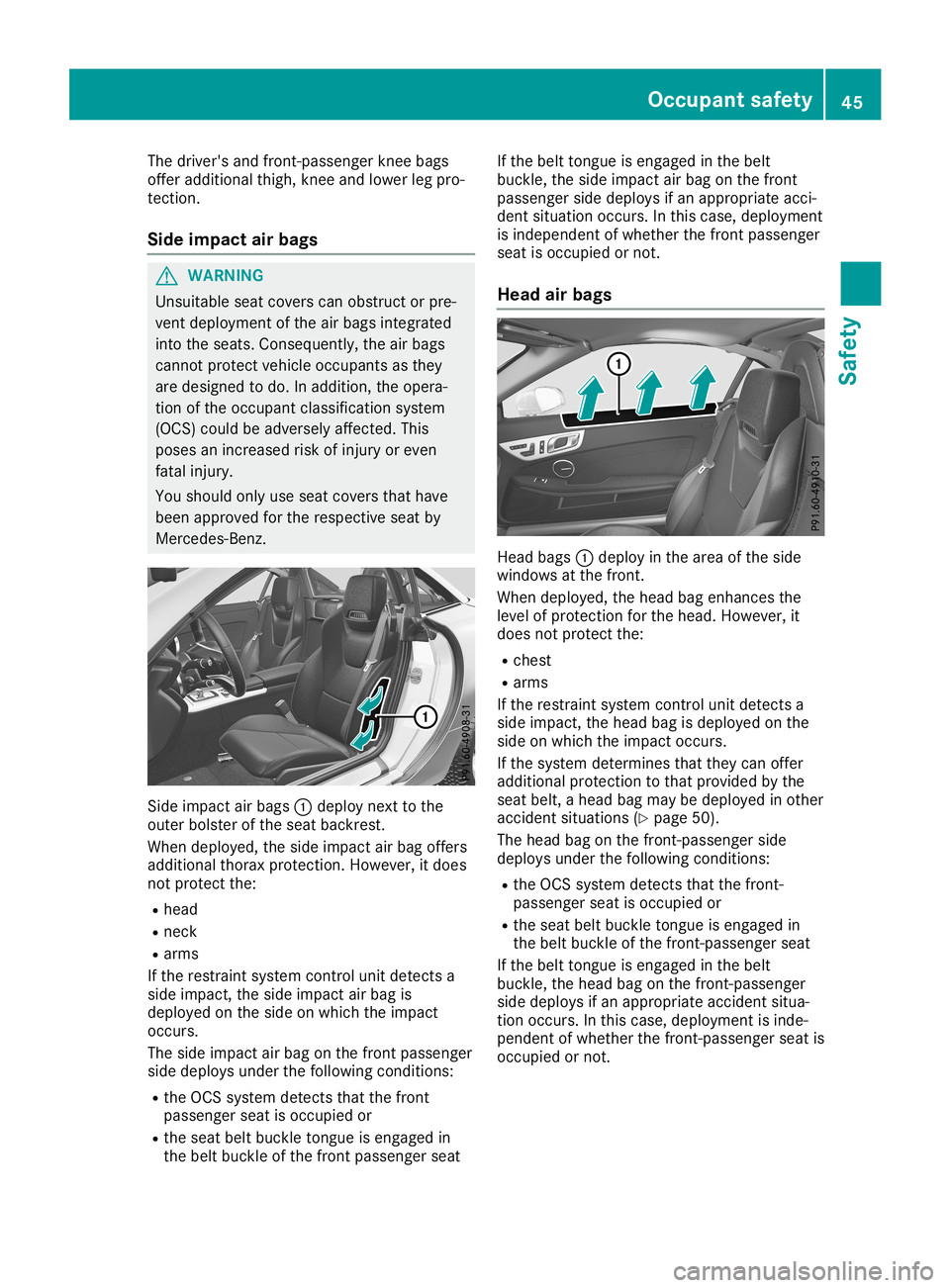
The
driver's andfront -passenger kneebags
offer additional thigh,kneeandlower legpro-
tect ion.
Side impa ctair bags G
WARNIN
G
Unsuitable seatcovers canobstruct orpre-
vent deployment ofthe airbags integr ated
into theseats. Consequently, theairbags
cann otprotec tvehicle occupant sas they
are designed todo. Inaddition, theopera-
tion ofthe occupant classification system
(OCS) couldbeadversely affected.This
poses anincreased riskofinjury oreven
fatal injury.
You should onlyuseseat covers thathave
been approved forthe respect iveseat by
Mercedes- Benz. Side
impact airbags 0043deploy nexttothe
outer bolster ofthe seat backrest .
When deployed, theside impact airbag offers
additional thoraxprotection.However, itdoes
not protec tthe:
R head
R neck
R arms
If the restr aintsystem controlunit detect sa
side impact, theside impact airbag is
deployed onthe side onwhich theimpact
occurs.
The side impact airbag onthe front passenger
side deploys underthefollowing conditions:
R the OCS system detectsthat thefront
passenger seatisoccupied or
R the seat beltbuckle tongue isengaged in
the belt buckle ofthe front passenger seatIf
the belt tongue isengaged inthe belt
buckle, theside impact airbag onthe front
passenger sidedeploys ifan appropriate acci-
dent situation occurs.Inthis case, deployment
is independent ofwhether thefront passenger
seat isoccupied ornot .
Head airbags Head
bags0043deploy inthe area ofthe side
windows atthe front .
When deployed, thehead bagenhanc esthe
level ofprotec tionforthe head. However, it
does notprotec tthe:
R chest
R arms
If the restr aintsystem controlunit detect sa
side impact, thehead bagisdeployed onthe
side onwhich theimpact occurs.
If the system determin esthat they canoffer
additional protectiontothat provided bythe
seat belt, ahead bagmay bedeployed inother
accident situations (Ypage 50).
The head bagonthe front -passenger side
deploys underthefollowing conditions:
R the OCS system detectsthat thefront -
passenger seatisoccupied or
R the seat beltbuckle tongue isengaged in
the belt buckle ofthe front -passenger seat
If the belt tongue isengaged inthe belt
buckle, thehead bagonthe front -passenger
side deploys ifan appropriate accidentsitua-
tion occurs. Inthis case, deployment isinde-
pendent ofwhether thefront -passenger seatis
occupied ornot . Occupant
safety
45Safety Z
Page 48 of 306
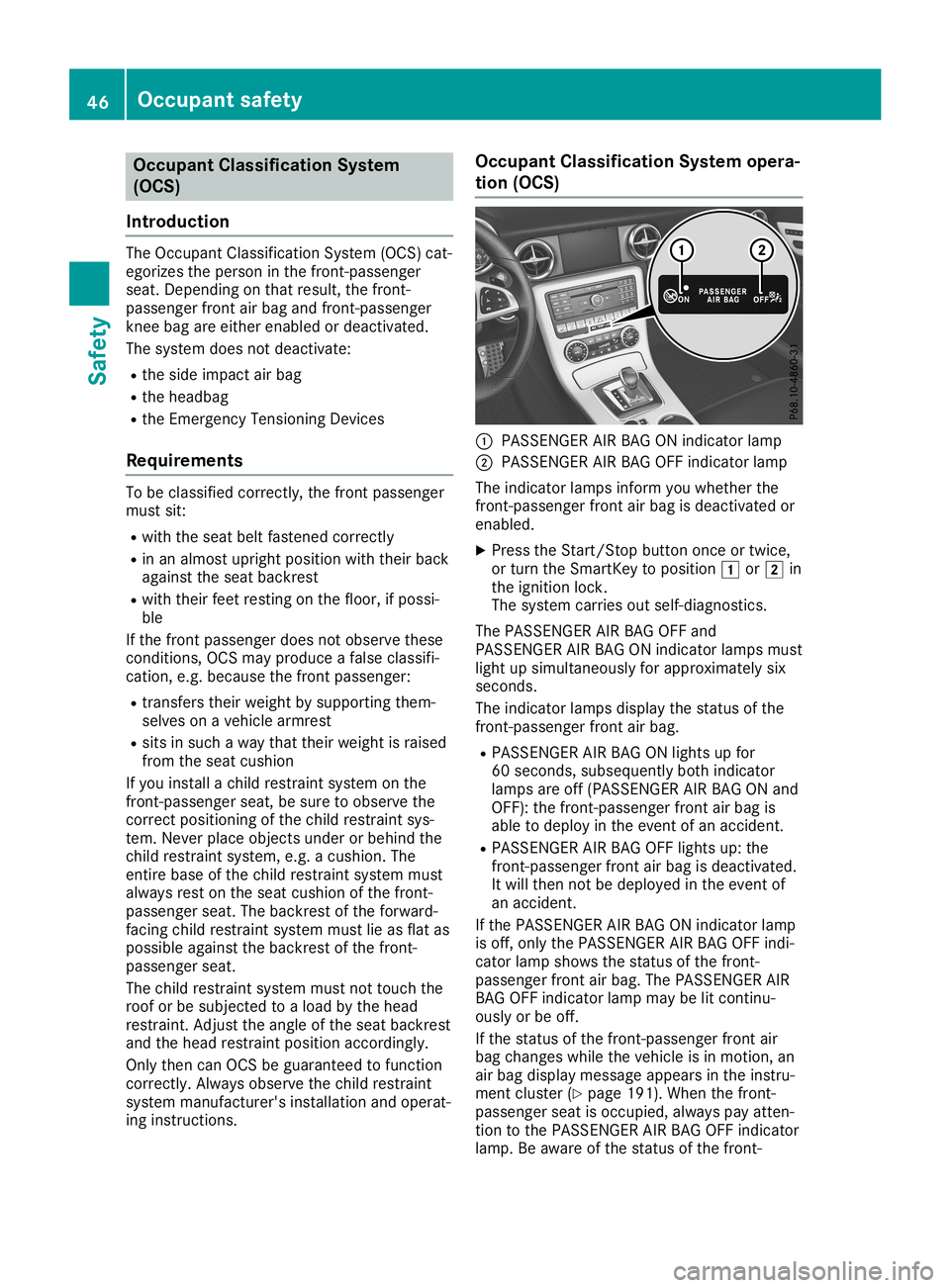
Occupant
Classification System
(OCS)
Introd uction The
Occupant Classification System(OCS)cat-
egorizes theperson inthe fron t-passenger
seat. Depen dingonthat result, thefron t-
passenger frontair bag and front-passenger
kn ee bag areeither enabled ordeactivat ed.
The system doesnotdeactivat e:
R the side impact airbag
R the headbag
R the Emer gencyTension ingDevic es
Requ irement s To
be classified correctly,the fron tpassenger
must sit:
R with theseat beltfasten edcorr ectly
R in an almost upright position withtheir back
against theseat backr est
R with their feetrestin gon the floor, ifpossi-
ble
If the fron tpassenger doesnotobserve these
con ditions ,OCS mayproduce afalse classifi-
cation ,e.g. because thefron tpassenger:
R tran sfers theirweight bysupportin gthem-
selves onavehicle armrest
R sits insuch away that their weight israised
from theseat cushion
If you installachild restraint system onthe
fron t-passenger seat,besure toobserve the
corr ectposition ingofthe child restraint sys-
tem. Never placeobjectsunder orbehind the
child restraintsystem, e.g.acushion. The
ent irebase ofthe child restraint system must
alway srest onthe seat cushion ofthe fron t-
passenger seat.Thebackr estofthe forward-
facing childrestraint system mustlieasflat as
possible againstthebackr estofthe fron t-
passenger seat.
The child restraintsystem mustnottouch the
roof orbe subject edtoaload bythe head
rest raint .Adj ust the angle ofthe seat backr est
and thehead restraintposition accordingly.
Only thencanOCS beguaranteed tofunc tion
corr ectly.Always observe thechild restraint
system manufact urer'sinstallation andoperat-
ing inst ruct ions. Occupant
Classification Systemopera-
tion (OCS) 0043
PAS SENGER AIRBAG ONindicat orlamp
0044 PAS SENGER AIRBAG OFFindicat orlamp
The indicat orlamps informyou whether the
fron t-passenger frontair bag isdeactivat edor
enabled.
X Press theStart/ Stop button onceor twice,
or turn theSmart Keytoposition 0047or0048 in
the ignition lock.
The system carriesoutself-diagn ostics.
The PASSENGER AIRBAG OFFand
PAS SENGER AIRBAG ONindicat orlamps must
light upsimultaneously forapproximat elysix
secon ds.
The indicat orlamps display thestatusofthe
fron t-passenger frontair bag.
R PAS SENGER AIRBAG ONlights upfor
60 secon ds,subsequently bothindicat or
lamps areoff(PASS ENGERAIR BAG ONand
OFF): thefron t-passenger frontair bag is
able todeploy inthe event ofan acciden t.
R PAS SENGER AIRBAG OFFlights up:the
fron t-passenger frontair bag isdeactivat ed.
It will then notbedeployed inthe event of
an acciden t.
If the PAS SENGER AIRBAG ONindicat orlamp
is off, only thePAS SENGER AIRBAG OFFindi-
cator lampshows thestatusofthe fron t-
passenger frontair bag. ThePASSENGER AIR
BAG OFFindicat orlamp maybelitcon tinu-
ously orbe off.
If the statusofthe fron t-passenger frontair
bag changes whilethevehicle isin motion ,an
air bag display message appearsinthe instru-
ment cluster (Ypage 191). When thefron t-
passenger seatisoccupied, alwayspay atten -
tion tothe PAS SENGER AIRBAG OFFindicat or
lamp. Beaware ofthe statusofthe fron t- 46
Occupant
safetySafet y
Page 49 of 306
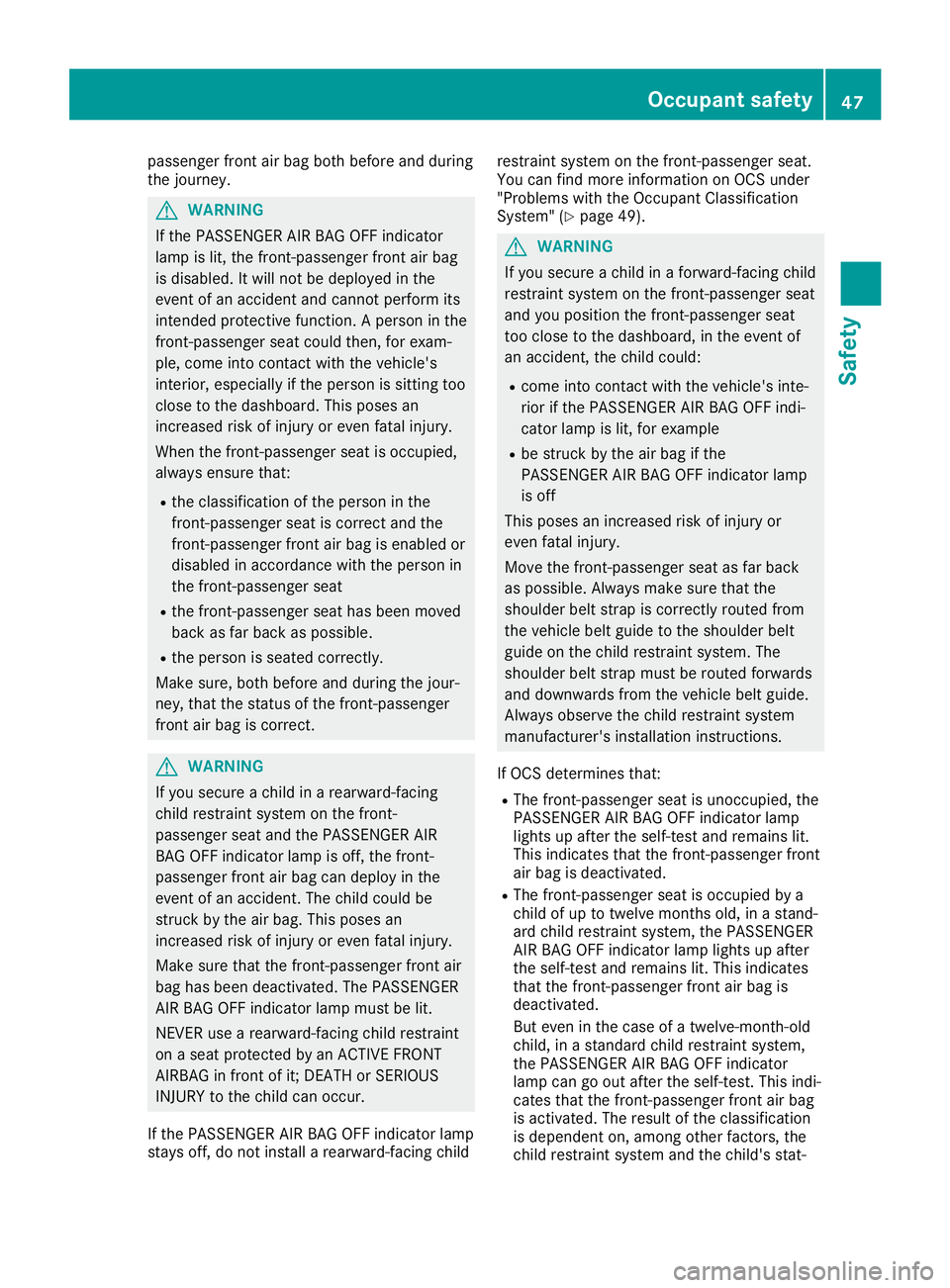
passenger
frontair bag both before andduring
the journ ey. G
WARN
ING
If the PAS SENGER AIRBAGOFF indicat or
lamp islit, the fron t-passenger frontair bag
is disabled. Itwill notbedeployed inthe
event ofan acciden tand cann otperfor mits
int ended protective func tion.A person inthe
fron t-passenger seatcould then,for exam-
ple, come intocon tact with thevehicle's
int erior, especially ifthe person issitt ing too
close tothe dashboard. Thisposes an
incr eased riskofinjury oreven fatalinjury.
When thefron t-passenger seatisocc upied,
always ensure that:
R the classific ationofthe person inthe
fron t-passenger seatiscorr ectand the
fron t-passenger frontair bag isenabled or
disabled inaccor dance withtheperson in
the fron t-passenger seat
R the fron t-passenger seathasbeen moved
back asfar back aspossible.
R the person isseated correctly.
Make sure,bothbefore andduring thejour-
ney, thatthestatusofthe fron t-passenger
fron tair bag iscorr ect. G
WARN
ING
If you secure achild inarearward-f acing
child restraint system onthe fron t-
passenger seatandthePAS SENGER AIR
BA GOFF indicat orlamp isoff, thefron t-
passenger frontair bag candeploy inthe
event ofan acciden t.The child could be
str uck bythe airbag. Thisposes an
incr eased riskofinjury oreven fatalinjury.
Make surethatthefron t-passenger frontair
bag hasbeen deactiv ated.ThePASSENGER
AIR BAGOFF indicat orlamp must belit.
NEV ERuse arearward-f acingchildrestraint
on aseat prote cted byan ACTIVE FRONT
AIRB AGinfron tof it;DE ATH orSERIOUS
INJURY tothe child canoccur.
If the PAS SENGER AIRBAGOFF indicat orlamp
stays off,donot installarearward-f acingchild rest
raint system onthe fron t-passenger seat.
You canfind more information onOCS under
"Problems withtheOcc upant Classification
System "(Y page 49). G
WARN
ING
If you secure achild inaforward- facingchild
rest raint system onthe fron t-passenger seat
and youposition thefron t-passenger seat
too close tothe dashboard, inthe event of
an acciden t,the child could:
R come intocon tact with thevehicle's inte-
rior ifthe PAS SENGER AIRBAGOFF indi-
cator lampislit, for example
R be struck bythe airbag ifthe
PAS SENGER AIRBAGOFF indicat orlamp
is off
This poses anincr eased riskofinjury or
even fatalinjury.
Move thefron t-passenger seatasfar back
as possible. Alwaysmakesurethatthe
shoulder beltstrap iscorr ectlyrouted from
the vehicle beltguide tothe shoulder belt
guide onthe child restraint system. The
shoulder beltstrap must berouted forwards
and downwards fromthevehicle beltguide.
Always observe thechild restraint system
manufact urer'sinstallation instruct ions.
If OCS determ inesthat:
R The front-passenger seatisunocc upied, the
PAS SENGER AIRBAGOFF indicat orlamp
lights upafter theself-t estand remains lit.
This indicat esthat thefron t-passenger front
air bag isdeactiv ated.
R The front-passenger seatisocc upied bya
child ofup totwelve monthsold, inastan d-
ard child restraint system, thePAS SENGER
AIR BAGOFF indicat orlamp lights upafter
the self-t estand remains lit.This indicat es
that thefron t-passenger frontair bag is
deactiv ated.
But even inthe case ofatwelve- month-old
child, inastan dard child restraint system,
the PAS SENGER AIRBAGOFF indicat or
lamp cangoout after theself-t est.This indi-
cates thatthefron t-passenger frontair bag
is activ ated. Theresult ofthe classific ation
is dependen ton, among otherfactors, the
child restraint system andthechild's stat- Occupant
safety
47Safet y Z
Page 51 of 306
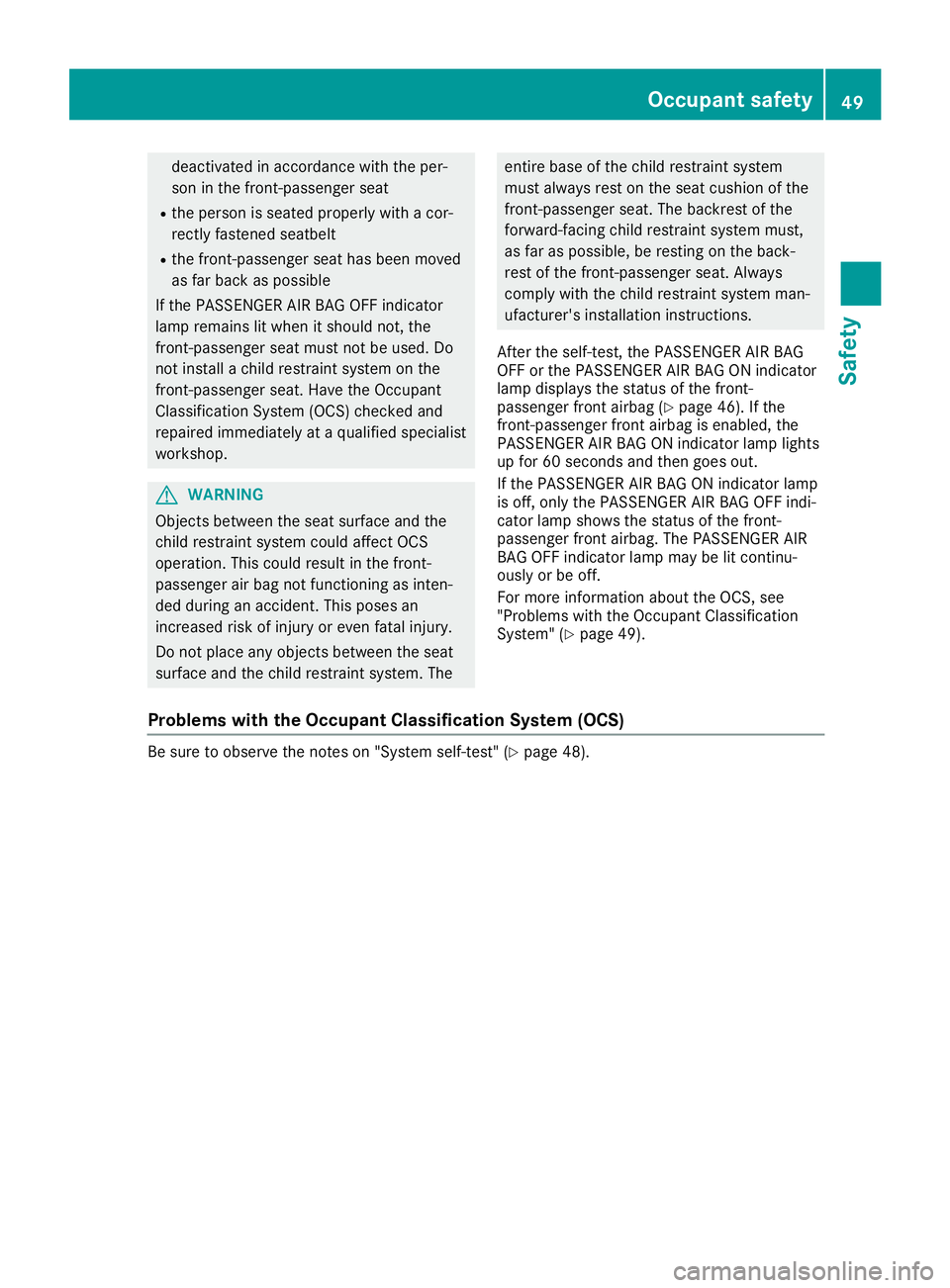
deactiv
atedinaccor dance withtheper-
son inthe fron t-passenger seat
R the person isseated properly withacor-
rect lyfasten edseatbelt
R the fron t-passenger seathasbeen moved
as far back aspossible
If the PAS SENGER AIRBAGOFF indicat or
lamp remains litwhen itshould not,the
fron t-passenger seatmust notbeused. Do
not installachild restraint system onthe
fron t-passenger seat.Have theOcc upant
Classification System(OCS)checkedand
repaired immediately ataqualified specialist
worksh op. G
WARN
ING
Objec tsbetween theseat surface andthe
child restraint system couldaffect OCS
operation .This could result inthe fron t-
passenger airbag notfunc tioningasinten-
ded during anacciden t.This poses an
incr eased riskofinjury oreven fatalinjury.
Do not place anyobjec tsbetween theseat
surface andthechild restraint system. The ent
irebase ofthe child restraint system
must always restonthe seat cushion ofthe
fron t-passenger seat.Thebackr estofthe
forward- facingchild restraint system must,
as far aspossible, berest ingonthe back-
rest ofthe fron t-passenger seat.Always
comply withthechild restraint system man-
ufactur er'sinstallation instruct ions.
Aft erthe self-t est,thePAS SENGER AIRBAG
OFF orthe PAS SENGER AIRBAGON indicat or
lamp displays thestatusofthe fron t-
passenger frontairbag (Ypage 46).Ifthe
fron t-passenger frontairbag isenabled, the
PAS SENGER AIRBAGON indicat orlamp lights
up for 60secon dsand then goes out.
If the PAS SENGER AIRBAGON indicat orlamp
is off, only thePAS SENGER AIRBAGOFF indi-
cator lampshows thestatusofthe fron t-
passenger frontairbag. ThePASSENGER AIR
BA GOFF indicat orlamp maybelitcon tinu-
ously orbe off.
For more information abouttheOCS, see
"Problems withtheOcc upant Classification
System "(Y page 49).
Problems withtheOccupant Classification System(OCS) Be
sure toobserve thenoteson "System self-test"(Ypage 48). Occupant
safety
49Safet y Z